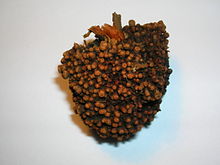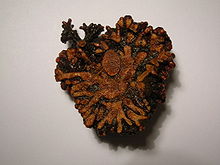Actinorrhiza
As actinorhizal plant (literally rays roots ) are root nodules of certain angiosperms called a symbiosis of these plants with nitrogen-fixing Actinobacteria the kind Frankia alni represent. Actinobacteria have a mycelium that radiates in all directions , hence their German name is radiation bacteria (Greek ακτινοσ "ray").
Actinorrhiza plants



With the exception of the herbaceous genus Datisca , all actinorrhizal plants are trees or shrubs . Many representatives are pioneer plants in the early stages of succession. They are often the first plants to repopulate sites after a disturbance. Some representatives specialize in extreme locations, such as floodplains, warm arid or semi-arid areas, or rocky locations. The nitrogen fixation can amount to 240 to 350 kg per hectare and year.
Actinorrhiza is known from 24 genera , which are divided into eight families in three orders :
The plants are widely used by humans: for soil remediation, as timber and firewood, for coastal remediation and to combat desertification .
Root nodules

The root nodules that arise in the course of the formation of the symbiosis differ anatomically significantly from the externally similar root nodules of legumes. Actinorrhiza nodules have a central vascular bundle . The infected tissue with the bacteria is located around this. This in turn is enclosed by a cortical parenchyma . The nodules are modified side roots . They are not determined, so they have potentially unlimited growth. At the tip of the nodule there is an apical meristem from which the nodule parenchyma develops. The meristem is followed by a zone of uninfected cells, followed by freshly infected cells that still lack the typical vesicles (infection zone). There are two types of cells in the central fixation zone: On the one hand, mature infected cells with vesicles. The nitrogen fixation takes place in these. On the other hand, non-infected cells, which probably serve to assimilate the fixed nitrogen and exchange carbon. The spatial distribution of infected and uninfected cells differs depending on the plant species.
The roots are infected with the bacteria, depending on the type of plant, in one of two ways:
- The intracellular or root hair infection is typical of the so-called primitive actinorrhizal plants. Here, a root hair pulls itself over a Frankia filament through an indentation . The cord of infection grows towards the inner root cortex. Immediately after infection, the root forms a new meristem in the outer cortex, the newly formed tissue is colonized by Frankia . Frankia forms the typical vesicles and begins to produce the enzyme nitrogenase , which is necessary for nitrogen fixation . This only temporarily existing tissue is called prenodule ("pre-nodules") and is characteristic of the intracellular path of infection. Later, the cells in the pericycle of the root begin to divide and form the primordium for the real nodules. This grows and then merges with the pre-nodule.
- With intercellular infection, the Frankia filaments pass through the intercellular space into the root tissue. The middle lamella of the cell wall is dissolved and the filament passes through the epidermis into the outer cortex area. In response to penetration, the plant deposits extracellular electron-dense material at the infection site.
In both cases, cell division begins and the nodule begins to form in the pericycle. The nodule is created analogously to a side root.
Little is known about the mechanisms of this symbiosis. The equivalent of the rhizobia NOD factors has not yet been discovered. Genes similar to those of legumes are expressed in the actinorrhizal nodules. The lack of genetic regulators and the fact that the majority of actinorrhizal plants are trees or shrubs have made their study difficult so far. Three Frankia genomes have recently been sequenced and RNAi developed, which should facilitate a better understanding of this symbiosis over the next few years.
supporting documents
- LG Wall: The Actinorhizal Symbiosis. In: Journal of Plant Growth Regulation. Volume 19, 2000, pp. 167-182. doi: 10.1007 / s003440000027
Individual evidence
- ^ Matthias Schaefer: Dictionary of Ecology. 4th edition. Spectrum Akademischer Verlag, Heidelberg / Berlin 2003, ISBN 3-8274-0167-4 , p. 10.
- ↑ L. Wall: The actinorhizal symbiosis. In: J. Plant Growth Regul. Vol. 19, 2000, pp. 167-182, doi: 10.1007 / s003440000027 .
- ↑ JK Vessey et al .: Root-based N2-fixing symbioses: Legumes, actinorhizal plants, Parasponia sp. and cycads. In: Plant and soil. Vol. 266, 2004, pp. 205-230.
- ^ V. Hocher et al.: Expressed sequence-tag analysis in Casuarina glauca actinorhizal nodule and root. In: New Phytol. Vol. 169, 2006, pp. 681-688. doi : 10.1111 / j.1469-8137.2006.01644.x
- ↑ H. Gherbi et al .: SymRK defines a common genetic basis for plant root endosymbioses with arbuscular mycorrhiza fungi, rhizobia, and Frankia bacteria. In: PNAS. Vol. 105, 2008, pp. 4928–4932, (online)
Web links
- Frankia and Actinorrhiza Page (University of Connecticut)

